Strategic Management Process Report for Jack Supermarket Stores
VerifiedAdded on 2022/11/17
|5
|1128
|160
Report
AI Summary
This report provides a comprehensive analysis of the strategic management process applied to Jack Supermarket, a retail chain. It begins with an introduction to strategic management, defining its purpose and importance. The report then outlines Jack Supermarket's strategic intent, including its mission, vision, goals, and objectives. A detailed SWOT analysis is presented, identifying the company's strengths, weaknesses, opportunities, and threats. Furthermore, a PESTLE analysis examines the political, economic, social, technological, legal, and environmental factors influencing the business. Porter's Five Forces are also applied to assess the competitive landscape. The report proceeds to discuss strategy formulation, planning, implementation, and evaluation, including internal responsibilities, stakeholder roles, performance indicators, resource allocation, and human resource management. Finally, the report concludes with an evaluation of the strategic management process's effectiveness and a list of references.
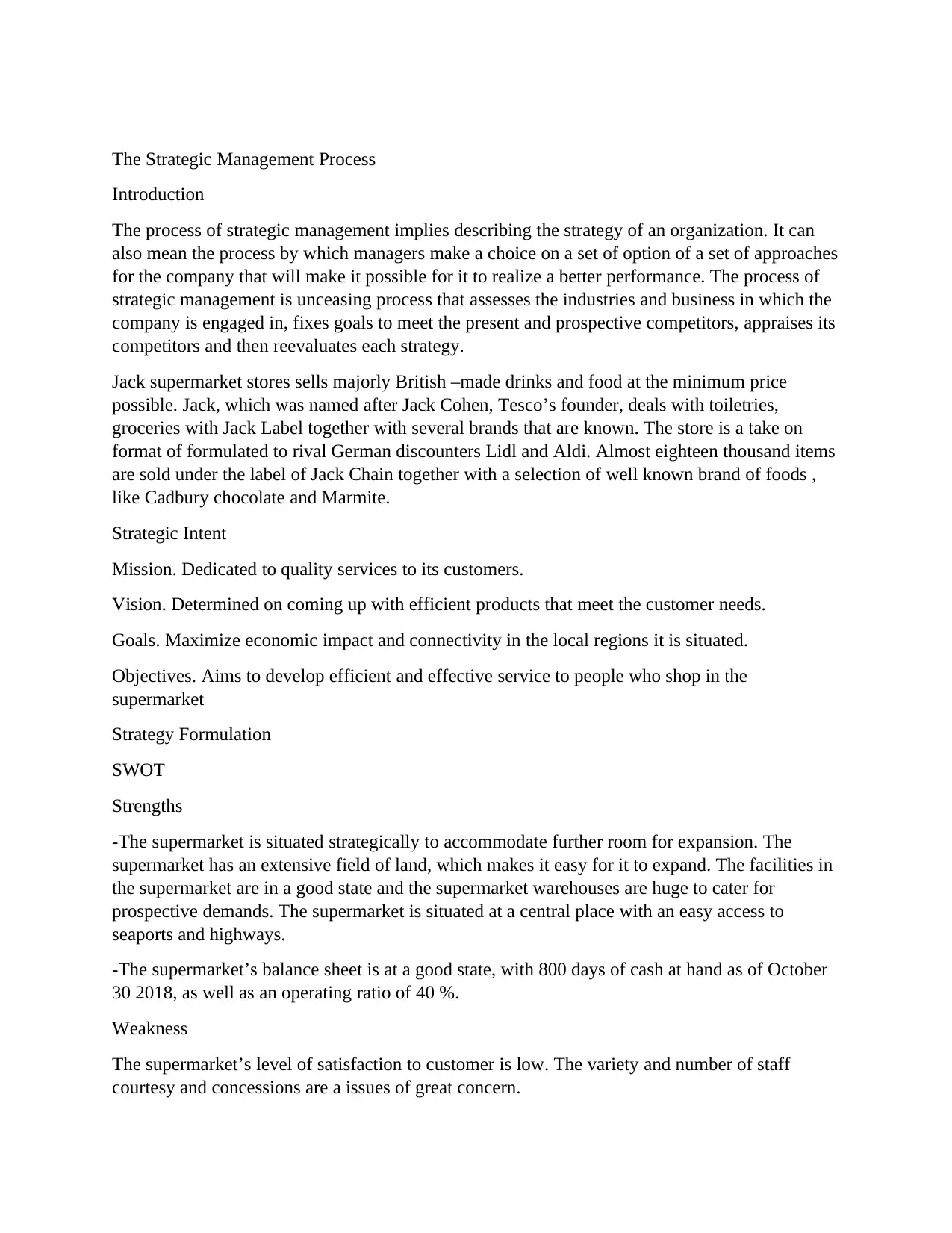
The Strategic Management Process
Introduction
The process of strategic management implies describing the strategy of an organization. It can
also mean the process by which managers make a choice on a set of option of a set of approaches
for the company that will make it possible for it to realize a better performance. The process of
strategic management is unceasing process that assesses the industries and business in which the
company is engaged in, fixes goals to meet the present and prospective competitors, appraises its
competitors and then reevaluates each strategy.
Jack supermarket stores sells majorly British –made drinks and food at the minimum price
possible. Jack, which was named after Jack Cohen, Tesco’s founder, deals with toiletries,
groceries with Jack Label together with several brands that are known. The store is a take on
format of formulated to rival German discounters Lidl and Aldi. Almost eighteen thousand items
are sold under the label of Jack Chain together with a selection of well known brand of foods ,
like Cadbury chocolate and Marmite.
Strategic Intent
Mission. Dedicated to quality services to its customers.
Vision. Determined on coming up with efficient products that meet the customer needs.
Goals. Maximize economic impact and connectivity in the local regions it is situated.
Objectives. Aims to develop efficient and effective service to people who shop in the
supermarket
Strategy Formulation
SWOT
Strengths
-The supermarket is situated strategically to accommodate further room for expansion. The
supermarket has an extensive field of land, which makes it easy for it to expand. The facilities in
the supermarket are in a good state and the supermarket warehouses are huge to cater for
prospective demands. The supermarket is situated at a central place with an easy access to
seaports and highways.
-The supermarket’s balance sheet is at a good state, with 800 days of cash at hand as of October
30 2018, as well as an operating ratio of 40 %.
Weakness
The supermarket’s level of satisfaction to customer is low. The variety and number of staff
courtesy and concessions are a issues of great concern.
Introduction
The process of strategic management implies describing the strategy of an organization. It can
also mean the process by which managers make a choice on a set of option of a set of approaches
for the company that will make it possible for it to realize a better performance. The process of
strategic management is unceasing process that assesses the industries and business in which the
company is engaged in, fixes goals to meet the present and prospective competitors, appraises its
competitors and then reevaluates each strategy.
Jack supermarket stores sells majorly British –made drinks and food at the minimum price
possible. Jack, which was named after Jack Cohen, Tesco’s founder, deals with toiletries,
groceries with Jack Label together with several brands that are known. The store is a take on
format of formulated to rival German discounters Lidl and Aldi. Almost eighteen thousand items
are sold under the label of Jack Chain together with a selection of well known brand of foods ,
like Cadbury chocolate and Marmite.
Strategic Intent
Mission. Dedicated to quality services to its customers.
Vision. Determined on coming up with efficient products that meet the customer needs.
Goals. Maximize economic impact and connectivity in the local regions it is situated.
Objectives. Aims to develop efficient and effective service to people who shop in the
supermarket
Strategy Formulation
SWOT
Strengths
-The supermarket is situated strategically to accommodate further room for expansion. The
supermarket has an extensive field of land, which makes it easy for it to expand. The facilities in
the supermarket are in a good state and the supermarket warehouses are huge to cater for
prospective demands. The supermarket is situated at a central place with an easy access to
seaports and highways.
-The supermarket’s balance sheet is at a good state, with 800 days of cash at hand as of October
30 2018, as well as an operating ratio of 40 %.
Weakness
The supermarket’s level of satisfaction to customer is low. The variety and number of staff
courtesy and concessions are a issues of great concern.
Paraphrase This Document
Need a fresh take? Get an instant paraphrase of this document with our AI Paraphraser
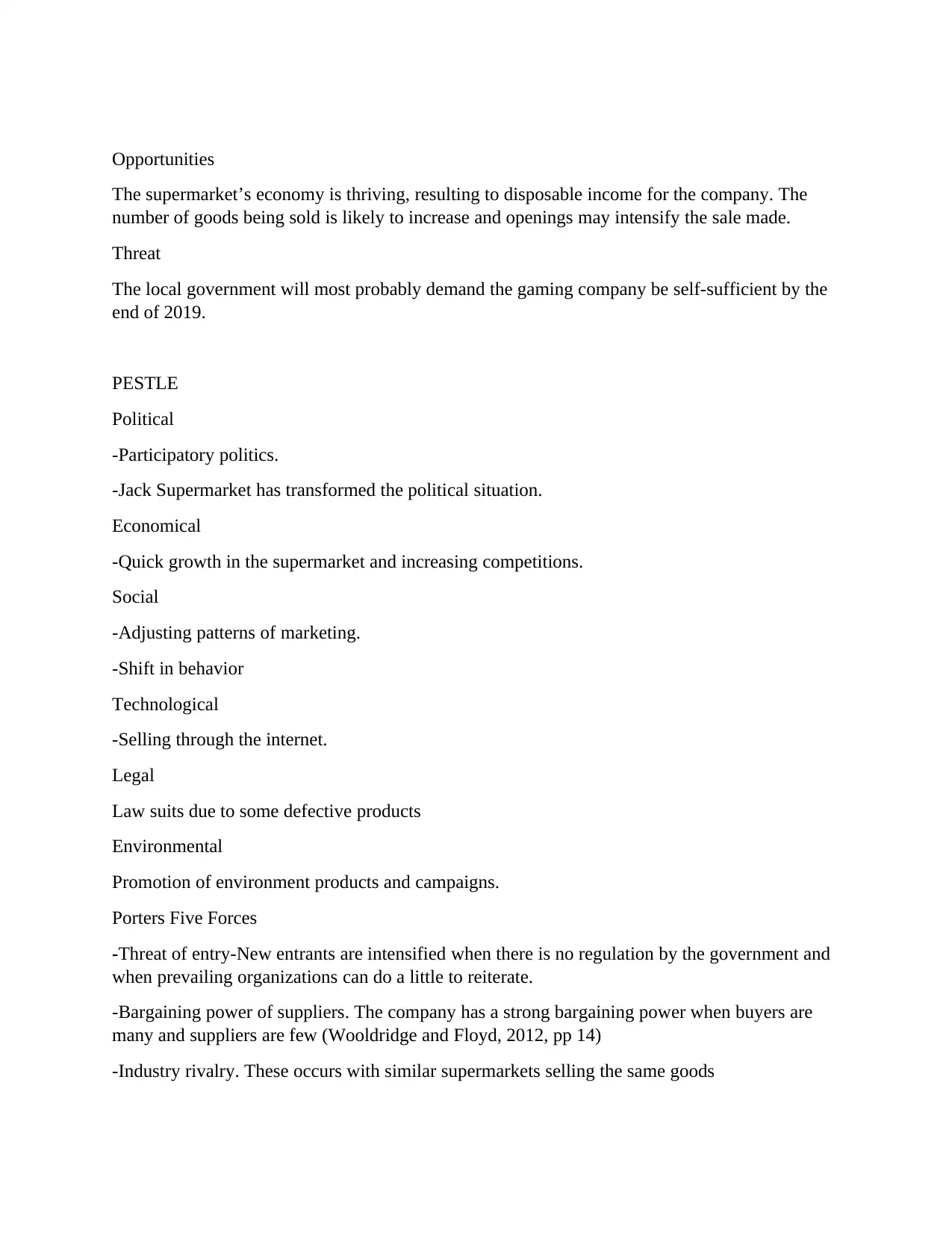
Opportunities
The supermarket’s economy is thriving, resulting to disposable income for the company. The
number of goods being sold is likely to increase and openings may intensify the sale made.
Threat
The local government will most probably demand the gaming company be self-sufficient by the
end of 2019.
PESTLE
Political
-Participatory politics.
-Jack Supermarket has transformed the political situation.
Economical
-Quick growth in the supermarket and increasing competitions.
Social
-Adjusting patterns of marketing.
-Shift in behavior
Technological
-Selling through the internet.
Legal
Law suits due to some defective products
Environmental
Promotion of environment products and campaigns.
Porters Five Forces
-Threat of entry-New entrants are intensified when there is no regulation by the government and
when prevailing organizations can do a little to reiterate.
-Bargaining power of suppliers. The company has a strong bargaining power when buyers are
many and suppliers are few (Wooldridge and Floyd, 2012, pp 14)
-Industry rivalry. These occurs with similar supermarkets selling the same goods
The supermarket’s economy is thriving, resulting to disposable income for the company. The
number of goods being sold is likely to increase and openings may intensify the sale made.
Threat
The local government will most probably demand the gaming company be self-sufficient by the
end of 2019.
PESTLE
Political
-Participatory politics.
-Jack Supermarket has transformed the political situation.
Economical
-Quick growth in the supermarket and increasing competitions.
Social
-Adjusting patterns of marketing.
-Shift in behavior
Technological
-Selling through the internet.
Legal
Law suits due to some defective products
Environmental
Promotion of environment products and campaigns.
Porters Five Forces
-Threat of entry-New entrants are intensified when there is no regulation by the government and
when prevailing organizations can do a little to reiterate.
-Bargaining power of suppliers. The company has a strong bargaining power when buyers are
many and suppliers are few (Wooldridge and Floyd, 2012, pp 14)
-Industry rivalry. These occurs with similar supermarkets selling the same goods
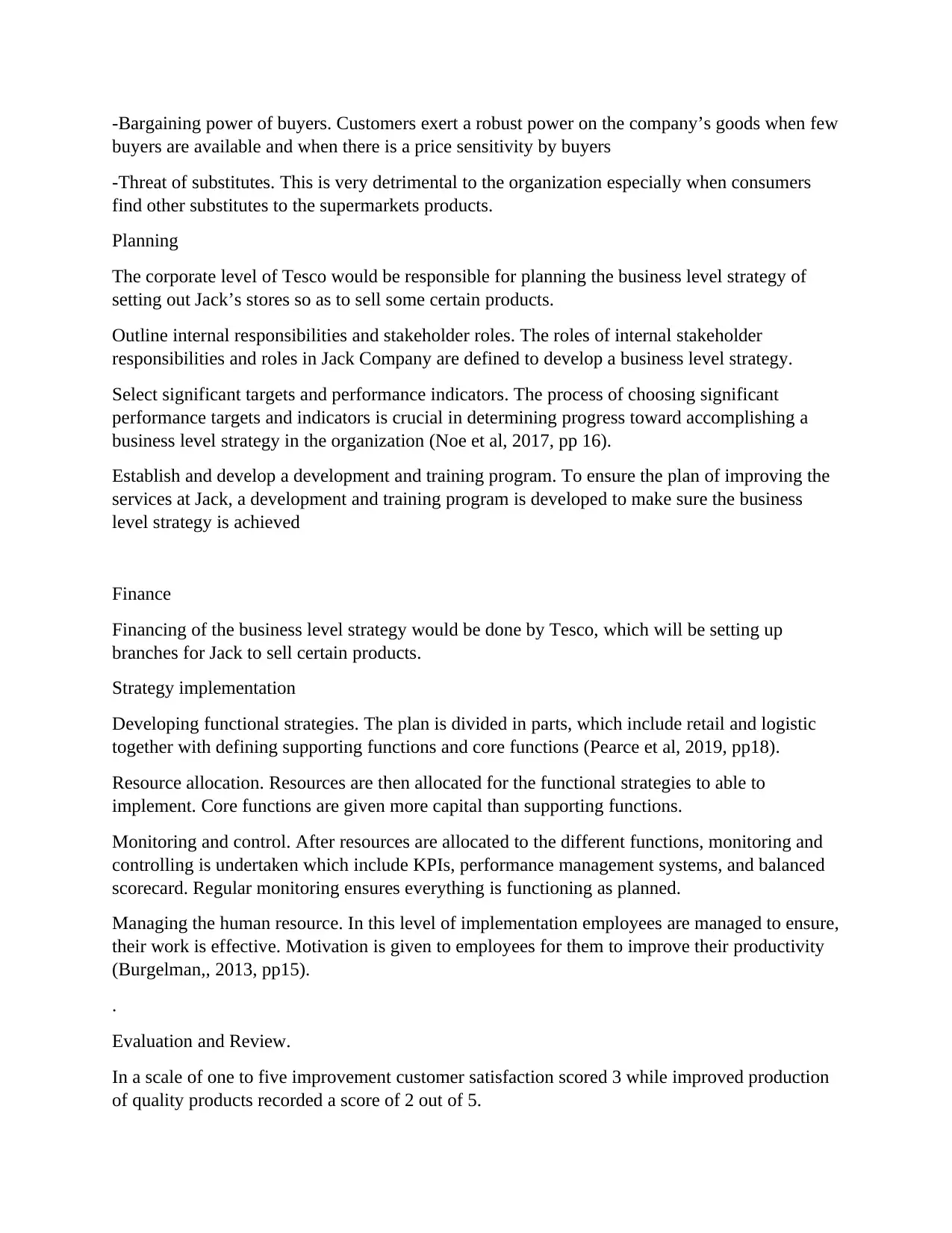
-Bargaining power of buyers. Customers exert a robust power on the company’s goods when few
buyers are available and when there is a price sensitivity by buyers
-Threat of substitutes. This is very detrimental to the organization especially when consumers
find other substitutes to the supermarkets products.
Planning
The corporate level of Tesco would be responsible for planning the business level strategy of
setting out Jack’s stores so as to sell some certain products.
Outline internal responsibilities and stakeholder roles. The roles of internal stakeholder
responsibilities and roles in Jack Company are defined to develop a business level strategy.
Select significant targets and performance indicators. The process of choosing significant
performance targets and indicators is crucial in determining progress toward accomplishing a
business level strategy in the organization (Noe et al, 2017, pp 16).
Establish and develop a development and training program. To ensure the plan of improving the
services at Jack, a development and training program is developed to make sure the business
level strategy is achieved
Finance
Financing of the business level strategy would be done by Tesco, which will be setting up
branches for Jack to sell certain products.
Strategy implementation
Developing functional strategies. The plan is divided in parts, which include retail and logistic
together with defining supporting functions and core functions (Pearce et al, 2019, pp18).
Resource allocation. Resources are then allocated for the functional strategies to able to
implement. Core functions are given more capital than supporting functions.
Monitoring and control. After resources are allocated to the different functions, monitoring and
controlling is undertaken which include KPIs, performance management systems, and balanced
scorecard. Regular monitoring ensures everything is functioning as planned.
Managing the human resource. In this level of implementation employees are managed to ensure,
their work is effective. Motivation is given to employees for them to improve their productivity
(Burgelman,, 2013, pp15).
.
Evaluation and Review.
In a scale of one to five improvement customer satisfaction scored 3 while improved production
of quality products recorded a score of 2 out of 5.
buyers are available and when there is a price sensitivity by buyers
-Threat of substitutes. This is very detrimental to the organization especially when consumers
find other substitutes to the supermarkets products.
Planning
The corporate level of Tesco would be responsible for planning the business level strategy of
setting out Jack’s stores so as to sell some certain products.
Outline internal responsibilities and stakeholder roles. The roles of internal stakeholder
responsibilities and roles in Jack Company are defined to develop a business level strategy.
Select significant targets and performance indicators. The process of choosing significant
performance targets and indicators is crucial in determining progress toward accomplishing a
business level strategy in the organization (Noe et al, 2017, pp 16).
Establish and develop a development and training program. To ensure the plan of improving the
services at Jack, a development and training program is developed to make sure the business
level strategy is achieved
Finance
Financing of the business level strategy would be done by Tesco, which will be setting up
branches for Jack to sell certain products.
Strategy implementation
Developing functional strategies. The plan is divided in parts, which include retail and logistic
together with defining supporting functions and core functions (Pearce et al, 2019, pp18).
Resource allocation. Resources are then allocated for the functional strategies to able to
implement. Core functions are given more capital than supporting functions.
Monitoring and control. After resources are allocated to the different functions, monitoring and
controlling is undertaken which include KPIs, performance management systems, and balanced
scorecard. Regular monitoring ensures everything is functioning as planned.
Managing the human resource. In this level of implementation employees are managed to ensure,
their work is effective. Motivation is given to employees for them to improve their productivity
(Burgelman,, 2013, pp15).
.
Evaluation and Review.
In a scale of one to five improvement customer satisfaction scored 3 while improved production
of quality products recorded a score of 2 out of 5.
⊘ This is a preview!⊘
Do you want full access?
Subscribe today to unlock all pages.

Trusted by 1+ million students worldwide
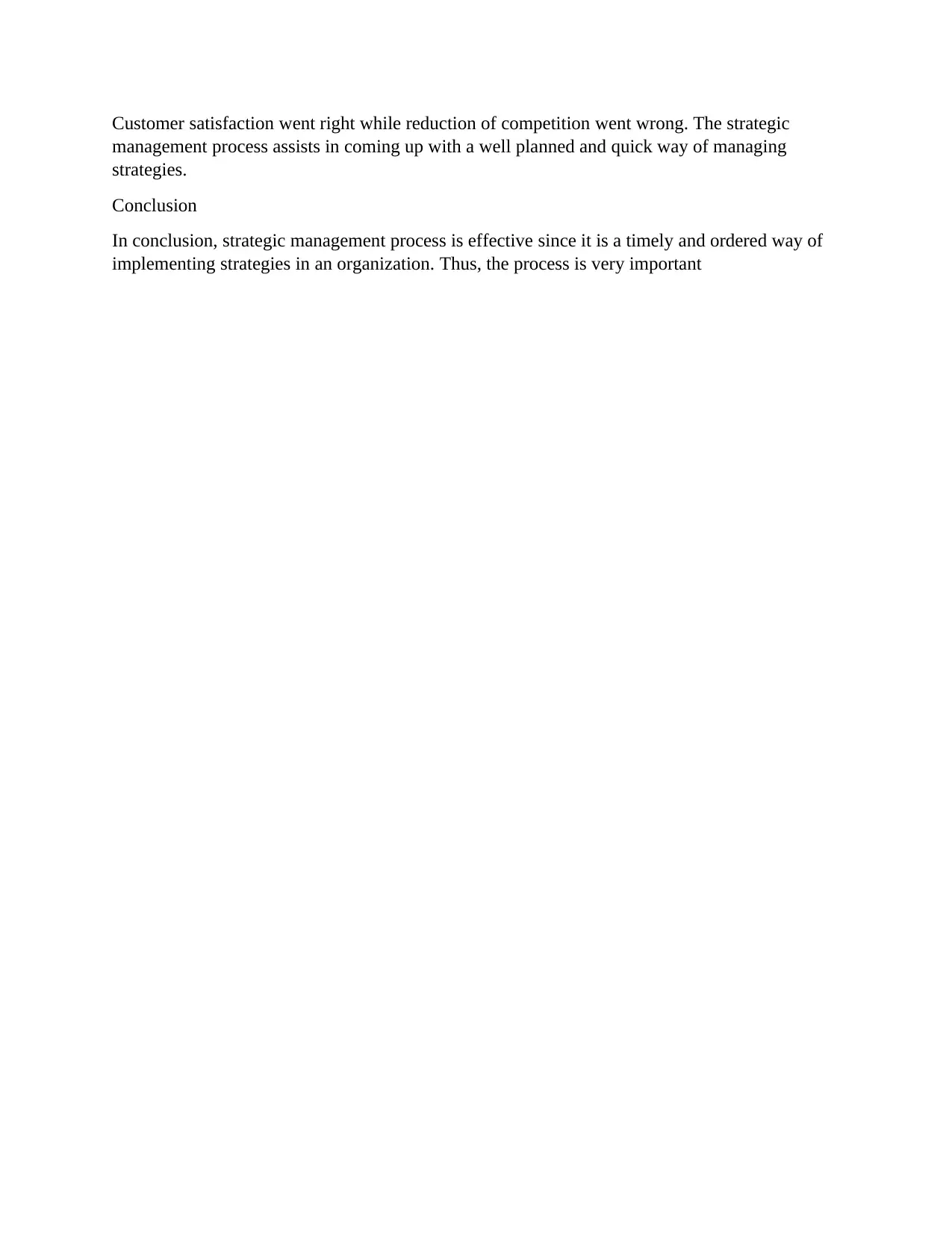
Customer satisfaction went right while reduction of competition went wrong. The strategic
management process assists in coming up with a well planned and quick way of managing
strategies.
Conclusion
In conclusion, strategic management process is effective since it is a timely and ordered way of
implementing strategies in an organization. Thus, the process is very important
management process assists in coming up with a well planned and quick way of managing
strategies.
Conclusion
In conclusion, strategic management process is effective since it is a timely and ordered way of
implementing strategies in an organization. Thus, the process is very important
Paraphrase This Document
Need a fresh take? Get an instant paraphrase of this document with our AI Paraphraser
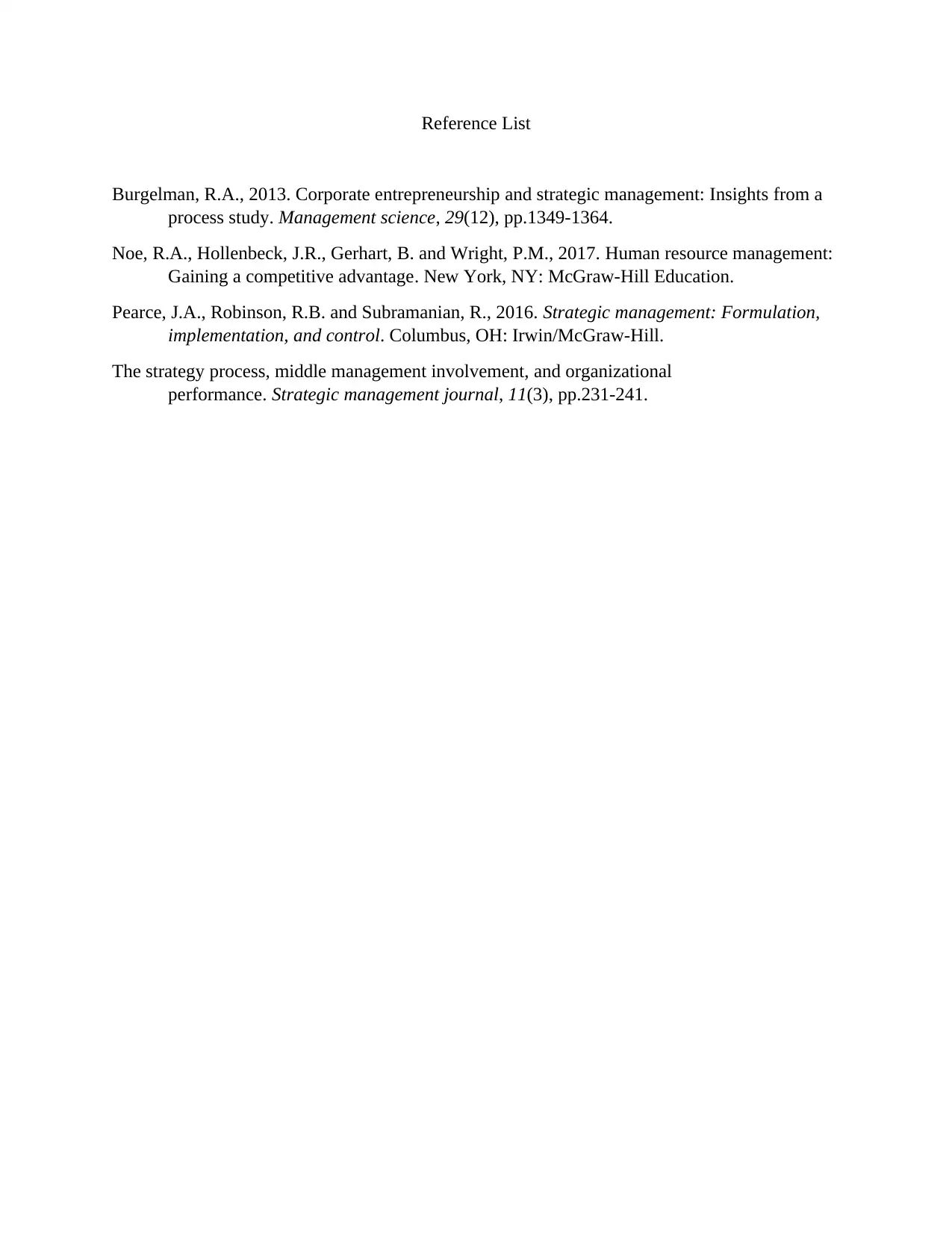
Reference List
Burgelman, R.A., 2013. Corporate entrepreneurship and strategic management: Insights from a
process study. Management science, 29(12), pp.1349-1364.
Noe, R.A., Hollenbeck, J.R., Gerhart, B. and Wright, P.M., 2017. Human resource management:
Gaining a competitive advantage. New York, NY: McGraw-Hill Education.
Pearce, J.A., Robinson, R.B. and Subramanian, R., 2016. Strategic management: Formulation,
implementation, and control. Columbus, OH: Irwin/McGraw-Hill.
The strategy process, middle management involvement, and organizational
performance. Strategic management journal, 11(3), pp.231-241.
Burgelman, R.A., 2013. Corporate entrepreneurship and strategic management: Insights from a
process study. Management science, 29(12), pp.1349-1364.
Noe, R.A., Hollenbeck, J.R., Gerhart, B. and Wright, P.M., 2017. Human resource management:
Gaining a competitive advantage. New York, NY: McGraw-Hill Education.
Pearce, J.A., Robinson, R.B. and Subramanian, R., 2016. Strategic management: Formulation,
implementation, and control. Columbus, OH: Irwin/McGraw-Hill.
The strategy process, middle management involvement, and organizational
performance. Strategic management journal, 11(3), pp.231-241.
1 out of 5
Related Documents
Your All-in-One AI-Powered Toolkit for Academic Success.
+13062052269
info@desklib.com
Available 24*7 on WhatsApp / Email
![[object Object]](/_next/static/media/star-bottom.7253800d.svg)
Unlock your academic potential
Copyright © 2020–2025 A2Z Services. All Rights Reserved. Developed and managed by ZUCOL.





